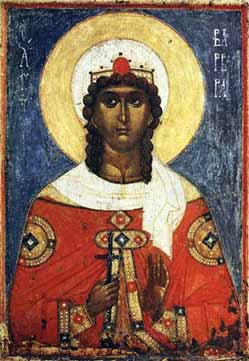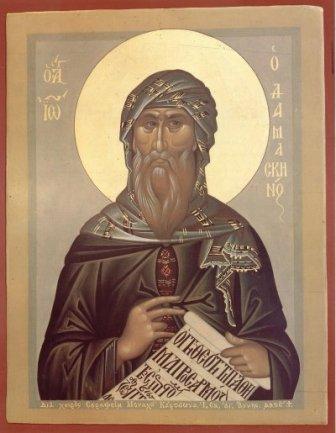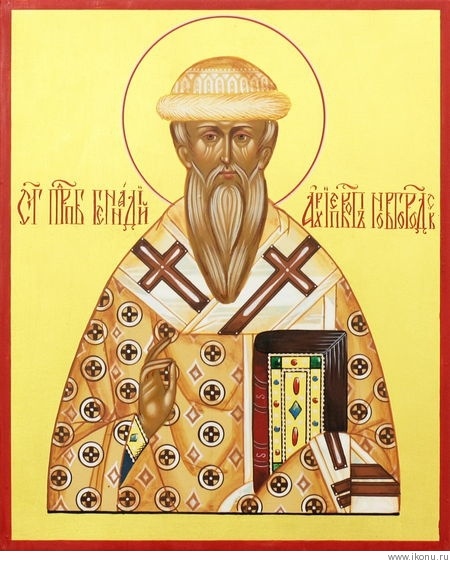|
|
The Holy and Great Martyr Barbara This famous follower of Christ was betrothed to Him from her early years. Her father, Dioscorus, was a pagan in the city of Heliopolis in Egypt, and was famed for his wealth and standing. Dioscorus shut up his only daughter, who was both intelligent and beautiful, in a high tower, surrounded her with all possible comforts, gave her a host of attendants, set up idols for worship and built her a bathroom with two windows. As she gazed through the windows of the tower upon the earth below and the starry sky above, Barbara"s mind was opened by the grace of God, and she came to know Him as the one, true God and Creator, although she had no human teacher to bring her to the knowledge of Him. Once, when her father was away from the city, she came out of the tower and, by God"s providence, met some Christians who told her about the true Christian faith. Barbara"s heart was set on fire with love for Christ. She had a third window cut in the bathroom as a symbol of the Holy Trinity, and traced a Cross with her finger on one wall of it, which etched itself deep in the stone as if cut by a chisel. A spring of water gushed forth from the bathroom floor from her footprint, and it later gave healing from sickness to many. When Dioscorus found out about his daughter"s faith, he beat her harshly and drove her from the tower, chasing after her to kill her, but a cliff opened and hid Barbara from her irate father. When she appeared again, Dioscorus took her to Marcian, the governor of the city, who handed her over for torture. The innocent Barbara was stripped and beaten until her entire body was covered in bloody wounds, but the Lord Himself appeared to her in the prison with many angels, and healed her. A certain woman, Juliana, beheld this and conceived a desire for martyrdom herself. Both of them were fearfully tortured and taken around the city to be mocked, then their breasts were cut off and much blood flowed from them. They were finally led out to the place of execution, and Juliana was slain by soldiers while Barbara was killed by her own father. On the same day, lightning struck Dioscorus"s house, killing both him and Marcian. St Barbara suffered in 306, and her wonderworking relics are preserved in Kiev. Greatly glorified in the Kingdom of Christ, she has appeared many times down to our own days, sometimes alone and sometimes in the company of the most holy Mother of God. This famous follower of Christ was betrothed to Him from her early years. Her father, Dioscorus, was a pagan in the city of Heliopolis in Egypt, and was famed for his wealth and standing. Dioscorus shut up his only daughter, who was both intelligent and beautiful, in a high tower, surrounded her with all possible comforts, gave her a host of attendants, set up idols for worship and built her a bathroom with two windows. As she gazed through the windows of the tower upon the earth below and the starry sky above, Barbara"s mind was opened by the grace of God, and she came to know Him as the one, true God and Creator, although she had no human teacher to bring her to the knowledge of Him. Once, when her father was away from the city, she came out of the tower and, by God"s providence, met some Christians who told her about the true Christian faith. Barbara"s heart was set on fire with love for Christ. She had a third window cut in the bathroom as a symbol of the Holy Trinity, and traced a Cross with her finger on one wall of it, which etched itself deep in the stone as if cut by a chisel. A spring of water gushed forth from the bathroom floor from her footprint, and it later gave healing from sickness to many. When Dioscorus found out about his daughter"s faith, he beat her harshly and drove her from the tower, chasing after her to kill her, but a cliff opened and hid Barbara from her irate father. When she appeared again, Dioscorus took her to Marcian, the governor of the city, who handed her over for torture. The innocent Barbara was stripped and beaten until her entire body was covered in bloody wounds, but the Lord Himself appeared to her in the prison with many angels, and healed her. A certain woman, Juliana, beheld this and conceived a desire for martyrdom herself. Both of them were fearfully tortured and taken around the city to be mocked, then their breasts were cut off and much blood flowed from them. They were finally led out to the place of execution, and Juliana was slain by soldiers while Barbara was killed by her own father. On the same day, lightning struck Dioscorus"s house, killing both him and Marcian. St Barbara suffered in 306, and her wonderworking relics are preserved in Kiev. Greatly glorified in the Kingdom of Christ, she has appeared many times down to our own days, sometimes alone and sometimes in the company of the most holy Mother of God.St John Damacene He was first a minister of Caliph Abdul-Malek, and then became a monk in the monastery of St Sava the Sanctified. For his ardent advocacy of the veneration of icons while still a courtier during the reign of the iconoclast Emperor Leo the Isaurian, he was slandered by the Emperor to the Caliph, who had his right hand cut off. John fell down in prayer before the icon of the most holy Mother of God, and his hand was re-joined to his arm and miraculously healed. When he beheld this wonder, the Caliph repented, but John no longer desired to remain at court as a nobleman, but to withdraw to a monastery. There, he was from the beginning a model of humility and obedience, and of all the works of asceticism prescribed for monks. He wrote the hymns for the Parting of the Soul from the Body, put together the Octoechos, the Irmologion, the Menologion and the Easter Canon, and wrote many theological works of an inspired profundity. A great monk, hymnographer and theologian, and a great warrior for the truth of Christ, Damascene is counted among the great Fathers of the Church. He entered peacefully into rest in about 749, being seventy-five years old. He was first a minister of Caliph Abdul-Malek, and then became a monk in the monastery of St Sava the Sanctified. For his ardent advocacy of the veneration of icons while still a courtier during the reign of the iconoclast Emperor Leo the Isaurian, he was slandered by the Emperor to the Caliph, who had his right hand cut off. John fell down in prayer before the icon of the most holy Mother of God, and his hand was re-joined to his arm and miraculously healed. When he beheld this wonder, the Caliph repented, but John no longer desired to remain at court as a nobleman, but to withdraw to a monastery. There, he was from the beginning a model of humility and obedience, and of all the works of asceticism prescribed for monks. He wrote the hymns for the Parting of the Soul from the Body, put together the Octoechos, the Irmologion, the Menologion and the Easter Canon, and wrote many theological works of an inspired profundity. A great monk, hymnographer and theologian, and a great warrior for the truth of Christ, Damascene is counted among the great Fathers of the Church. He entered peacefully into rest in about 749, being seventy-five years old.St Gennadius, Archbishop of Novgorod A writer of note, a champion of truth and one who suffered for the truth of Christ he brought the various books of Sacred Scripture together in one book, and composed a system to find the date of Easter (the Pachalia) for the next five hundred and thirty-two years. He entered into rest in the Lord in 1505. His wonderworking relics are preserved in the Chudov monastery in Moscow. A writer of note, a champion of truth and one who suffered for the truth of Christ he brought the various books of Sacred Scripture together in one book, and composed a system to find the date of Easter (the Pachalia) for the next five hundred and thirty-two years. He entered into rest in the Lord in 1505. His wonderworking relics are preserved in the Chudov monastery in Moscow. |